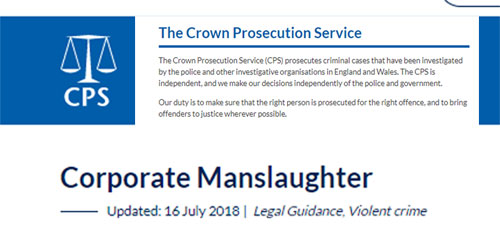The Corporate Manslaughter and Corporate Homicide Act 2007 came into effect in 2008 in response to a number of large-scale disasters in the 1990s and acts to impose criminal responsibility on organisations where gross negligence has led to the death of an employee. Although it is not part of health and safety law, corporate manslaughter is a criminal offence that refers to a crime committed by a company or organisation that leads to a work-related death. It introduced a new element in the corporate management of health and safety.
An organisation is guilty of a corporate manslaughter offence if the way in which its activities are managed or organised causes a person’s death, and if this amounts to a gross breach of a relevant duty of care owed by the organisation to the deceased. Organisations affected by the legislation include:
|
Corporations
Most government departments and governmental agencies (including local authorities by implication)
Police forces
Partnerships, trade unions or employers’ associations that act as employers` |
How do you prove corporate manslaughter?
In 2019/20 111 workers were killed at work in Great Britain which, despite being 38 fewer than the previous year, is still a significantly high number. Since the Corporate Manslaughter and Corporate Homicide Act was introduced into UK law, there have been fewer than 30 convictions.
It is rare that a company will be charged with corporate manslaughter because in order to be found guilty, all
of the following needs to be proved:
|
The defendant is a qualifying organisation;
The organisation owed a relevant duty of care to the deceased;
There was a gross breach of that duty by the organisation;
the way in which its activities were managed or organised by its senior;
Management was a substantial element in the breach; and
the gross breach of the organisation’s duty caused or contributed to the death.` |
A substantial element of any duty of care breach needs to be in the way activities were managed or organised. In other words, senior management must play a substantial role. However, in most, if not all workplace fatalities, very rarely is there a single factor that results in such a tragic outcome – fault is typically attributed to many different aspects.
Demonstrating that senior management failure was a substantial cause of any duty of care breach has been the biggest hurdle to overcome in making corporate manslaughter cases stick. Of the convictions that have been granted, majority of them have been smaller-sized companies where identifying a ‘senior manager’ connected to the company’s gross failure has been possible.
What is the maximum sentence for corporate manslaughter?
Conviction of corporate manslaughter carries an unlimited fine – it is stated that this fine must be enough to significantly punish the organisation, but should not be enough to put the organisation out of business or cause harm to other employees. The guidelines suggest that the fine should be 5% of the company’s annual turnover in the first instance and 10% for all subsequent incidents, meaning this can rise to several million pounds for large corporations.
It is also possible for prosecution costs to be awarded against the organisation and courts are able to impose ‘remedial orders’ on companies found guilty, forcing them to change their procedures to comply with health and safety laws. Additionally, since 2010, it has been possible to order companies to publicise the fact that they have been convicted.
It is important to note that by definition, corporate manslaughter charges can only be found against an organisation, although, individuals involved can be prosecuted for either gross negligence manslaughter or any related health and safety offences.
Where the factors needed to be found guilty of corporate manslaughter are not present, the organisation may instead be charged with negligence or gross negligence. “Gross negligence” is more severe and is determined if the breach is deemed to be significantly below what would be reasonably expected by the organisation. The level of negligence decided will be based on several factors:
|
How serious the failure was
How significant the risk was
The attitudes, policies and practices of the organisation that led to the failure
Any previous convictions of health and safety failure
Any health and safety guidance relating to the breach
The defendant is a qualifying organisation;
|
|
